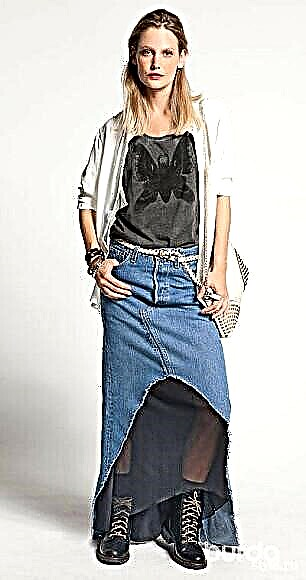According to these patterns and the master class, you can sew warm soft boots with lining of different sizes (from 35.5 to 42).

These boots are constructed on the same principle as classic ugg boots. They are quite free and spacious, while they sit well on the foot. The bootleg is high enough - you can make it lower by wrapping, or shortening the corresponding details of the pattern. Boots in this master class are made of smooth fleece (face) and faux fur (lining). If you want fluffy boots, the materials can be swapped. Also, for boots, you can take dense natural material (including for lining), and for volume and heat add bulk material, for example, synthetic winterizer. Also, artificial suede, a dense knitted fabric (including, for example, an unnecessary sweater), flannel, velor are suitable for the face of boots. For the sole, it’s good to take a denser material, perhaps rubberized, so the boots will not slip. Also, a dense suede or leather is suitable for the sole - if you opt for these materials, use special needles for the skin. In this case, the sole is made of the main material - of dense fleece. Due to the insole of felt / batting, it turns out to be quite warm.
Felting wool slippers: master class
You will need:

- material for the front of the boots;
- material for lining boots;
- batting or felt for warming the soles;
- material for the sole;
- scissors;
- pins;
- printer, paper, scissors and glue for the pattern;
- iron;
- sewing machine and thread.
DIY warm knitted slippers
Step 1
Download, print, glue and cut patterns here.
Allowances of 1.5 cm are taken into account in all details (no allowances are needed).
Cut out all the details from the right materials.
Step 2

Fold the front part of the boot and the lower front part of the boot with the sides facing inward, as shown in the photo. Chip the parts with pins and sew. Make a notch. Flatten the seam. Repeat for the second boot.
Step 3


Complete the side seams of the boot. Flatten the seams. Repeat for the second boot.
Step 4

Repeat steps 2 and 3 for lining details. On the inner seam of the bootleg, leave a section of about 5 cm long unstitched (see photo).
Step 5

Fold the felt / batting part with the sole part so that the insulation is inside out of the sole part. Lay the seam around the perimeter, backing 1 cm from the edge. Repeat for the second boot.
Step 6

Sew the sole details to the main fabric boot.
Step 7

Turn the front boot. Put it in the lining boot. Align the side seams and sew along the top edge, backing off 2 cm from the top. Repeat for the second boot.
Step 8

Iron the allowances to the side of the lining parts and stitch the seam back 2-3 mm. Repeat for the second boot.
Step 9

Turn the bottom of the lining of the boot through the hole and sew on it the sole part from the lining material. Repeat for the second boot.
Step 10

Turn out the boots and sew a hole in a hidden seam. It remains only to fill the lining inward. Done!

Photo and source: tillyandthebuttons.com
Ideas for using different materials and decor options for home boots:
Thick cotton is selected for the front of these boots:

Photo: howtocrafts. ml
More options in cotton:

Photo: etsy.com/BeautifulPieShop
Here is a fleece on both sides, smooth and fluffy:

Photo: naehjunkie.com
Knitwear + lace and button trim:

Photo: kreativlaborberlin. de
Knitted fabric + rough manual seam (without lining):

Photo: serviceyard.net
Fringed Trim:

Photo: diycraftsrecipes.com
These boots are made of double-sided material, the lining is not needed, the side seams are made with allowances outside:

Photo: sewcando.com



